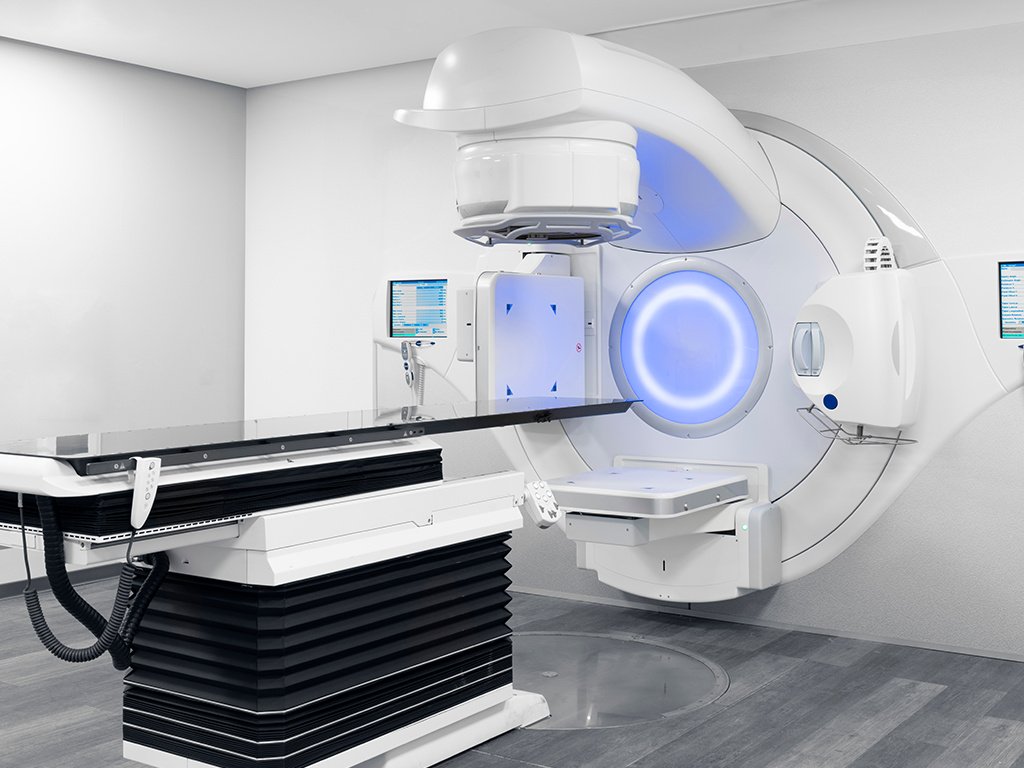Wireless Infrastructure

Particle accelerators play a pivotal role in modern medical applications, particularly in cancer treatment and diagnostics. These sophisticated machines generate high-energy particles that can be used to treat tumors or create detailed images of internal structures. As the demand for more precise and efficient medical treatments grows, the technology behind particle accelerators continues to evolve. RFHIC's gallium nitride (GaN) solid-state solutions are at the forefront of this evolution, offering significant advantages over traditional technologies.
Types of Medical Particle Accelerators

Linear Accelerators (Linacs)
Linear accelerators (Linacs) are the most used particle accelerators in medical applications, particularly for radiation therapy. Linacs accelerate electrons along a linear path to produce high-energy X-rays or electron beams. These beams are precisely targeted at cancerous tumors, destroying cancer cells while minimizing damage to surrounding healthy tissue.
Cyclotrons
Cyclotrons are circular accelerators that propel charged particles, such as protons, in a spiral path. These particles are used to produce radioisotopes for medical imaging techniques like Positron Emission Tomography (PET) scans.
Synchrotrons
Synchrotrons are advanced particle accelerators that use magnetic fields to keep charged particles, such as protons or heavy ions, on a circular path while increasing their energy. Synchrotrons are employed in proton therapy and heavy-ion therapy, cutting-edge treatments for cancer.
Proton Accelerators
Proton accelerators are designed to generate protons for proton therapy, a form of radiation therapy that uses protons instead of X-rays. Proton therapy is known for its precision and ability to deliver high doses of radiation directly to tumors while sparing surrounding healthy tissues.
Heavy-Ion Accelerators
Heavy-ion accelerators are like proton accelerators but use heavier ions, such as carbon ions, for cancer treatment. Heavy-ion therapy is particularly effective against radio-resistant tumors and those located deep within the body【56†source】.
The Role of RFHIC's GaN Solid-State Solutions in Medical Particle Accelerators
While particle accelerators have been transformative in medical applications, the underlying technology is continuously evolving. Traditional accelerators often rely on LDMOS or tube-based klystrons, which, although effective, come with limitations such as lower efficiency, larger size, and greater heat generation.
Advantages of RFHIC’s GaN Solid-State Technology
RFHIC's GaN solid-state technology offers several significant advantages over conventional LDMOS and tube-based technologies:
Higher Efficiency: GaN technology provides superior efficiency compared to LDMOS and klystrons, converting more energy into the desired high-frequency signals and reducing power consumption and operating costs【55†source】.
Compact Design: GaN solid-state devices generate less heat, allowing for smaller and more compact accelerator designs. This compactness is particularly valuable in medical environments, where space is often at a premium【58†source】.
Fast Start-Up Times: GaN technology offers rapid start-up times, enabling accelerators to reach operational levels more quickly, which is crucial in medical settings where time is of the essence【58†source】.
Increased Reliability: GaN devices have a longer operational lifespan and require less maintenance than traditional tube-based technologies, reducing downtime and ensuring consistent, high-quality performance in medical applications【58†sbource】.
Precise Energy Control: The ability to finely control the energy output of GaN-based systems enhances the precision of medical particle accelerators. This precision is critical in treatments like proton and heavy-ion therapy, where targeting accuracy can significantly impact patient outcomes【57†source】.
RFHIC’s GaN Solid-State Solutions for Particle Accelerator Applications
|
No. |
Category |
Frequency Min (MHz) |
Frequency Max (MHz) |
Output Power (W/kW) |
Voltage (V) |
Efficiency (%) |
Power Gain (dB) |
|
ID001K5DD-F |
Transistor | 1 | 400 | 1200 | 60 | 75 | 23 |
| ID001K5DD-P | Transistor | 1 | 400 | 1200 | 60 | 75 | 23 |
|
ID001K5DD-NP |
Transistor | 1 | 400 | 12011000 | 60 | 75 | 23 |
| IE051K2DC | Transistor | 495 | 505 | 605 | 50 | 74.7 | 18.8 |
| IE05600DC | Transistor | 499 | 501 | 550 | 50 | 76.4 | 19.1 |
| IE13550D | Transistor | 1295 | 1305 | 300 | 50 | 79.2 | 14.9 |
| IE30330PC | Transistor | 2800 | 3100 | 50 | 50 | 63 | 11 |
| IE6305040V | Transistor | 5725 | 5875 | 1 kW | 40 | 55 | 13.7 |
| RIM051K0-20 | Amplifier | 589 | 593 | 2 kW | N/A | 68 | N/A |
| RIM132K0-20 | Amplifier | 1295 | 1305 | 1 kW | N/A | 65 | N/A |
| RIM151K0-20 | Amplifier | 1496 | 1502 | N/A | 62 | N/A | |
|
RIU00273K0-20TG |
Microwave Generator | 25.8 | 28.5 | ||||
|
RIK1330K-40TG |
Microwave Generator | 1295 | 1305 | 30 kW | N/A | 50 | N/A |
|
RIK154K0-40T |
Microwave Generator | 1496 | 1502 | 4 kw | N/A | 53 | N/A |
Conclusion
Medical particle accelerators have become vital tools in diagnosing and treating cancer. From linear accelerators to heavy-ion accelerators, each type of accelerator offers unique benefits that cater to specific medical needs. As the demand for more effective and efficient cancer treatments grows, so does the need for advanced technologies that can enhance the performance of these critical devices.
RFHIC's GaN solid-state microwave solutions are at the forefront of this evolution, offering significant advantages over traditional LDMOS and tube-based klystron technologies. With higher efficiency, compact design, fast start-up times, increased reliability, and precise energy control, RFHIC's GaN solutions are revolutionizing the field of medical particle accelerators. These innovations not only improve the quality and effectiveness of cancer treatments but also contribute to better patient outcomes, advancing the field of medical science.